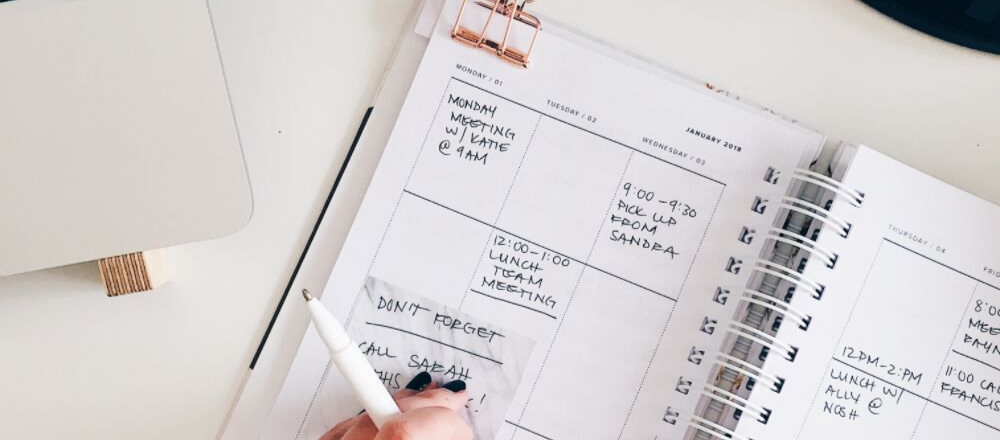Quick Summary
- Write down each day’s tasks ahead of time
- Organize tasks in their order of priority
- Allocate time for your tasks
- Include some contingency time on your schedule
- Reevaluate the items on your planner
- Write a journal
How you plan your day to day activities on the work can make or break your productivity. This may start in the morning, the day before, or even a week or two prior.
Being organized will have a significant impact on your productivity. It means having time allocated for each task, and strategies for completing the various tasks in the shortest time possible.
Planning a workday optimally is easier said than done. If you frequently or occasionally find yourself having a busy day at work only to accomplish little at the end, then you’re not alone. Like many people, all you need is to shake things up a bit.
This guide provides you with the proven strategies that you need to implement to organize your work day(s) better. Done correctly, you should see your efficiency and productivity shoot up. Let’s dive right in.

Write down each day’s tasks ahead of time
What tasks do you want to do during the day? At what time must you complete each? Do you have enough time for them?
You must start each day with clear answers to these questions. That is where a calendar or planner comes in. It could be a weekly or daily planner. The planner could be in digital form, or you could go old school and use a simple notebook.
It is important that you choose your planner based on your taste and budget. The tool of choice also needs to be functional as to get the job done.
It should be easy to enter data, as well as view the items alongside the allocated time in the exact level of detail you need.
A digital calendar should make more sense if you’re looking for convenience. You can have the calendar on your phone or tablet and be able to carry it with you anywhere. Or you could have it in the cloud where you can access it using your laptop, phone, tablet or any other internet enabled device with a display screen.
Most digital calendars like Google Calendar or MS Outlook allow you to synch the data and make it accessible on all your electronic devices. This ensures that you always have your calendar ready anywhere, any time. Some solutions also include reminders, so you do not miss a schedule.
The digital planner also allows you to include notes where necessary, or make any required changes with ease.
Whether you choose a paper or digital planner, ensure it documents the plan of activities for the week right before the week begins. For a daily calendar, update the schedule for the day on the day before.
The idea is to approach each day with a clear, detailed to-do list. This is the surest way to manage your time more efficiently. It increases your likelihood to get the more important tasks done in time and reduces any chances of forgetting things.
How to approach your calendar
Ideally, you need to structure your day in a manner to have enough (or more) time for essential tasks.
Unless you are generally more productive at a different time other than morning, your day should start off with the more critical tasks. This way, you are more likely to complete them within the day. The less important tasks can always wait until later if there is not enough time.
1. Organize tasks in their order of priority
Start by listing all the tasks that you need to do. Then from the list, sort the items in their order of priority. What’s more urgent, and what’s more important? What’s more challenging? Which tasks are likely to take more time to complete?
Those tasks that are most important should come first on your schedule. They need to be given priority to be completed first. Those that are less important should be scheduled to wait or be placed towards the end of the day or week – depending on your calendar type.
Once you have identified and sorted out your tasks in order of priority, it’s time to mark them. Electronic calendars will make it easy to do this. They are loaded with features such as color codes that you can use to set apart high priority tasks from the rest.
This is also the time to make notes on your planner. In case there is something you need to remember about a task, make sure you note it down. Each note placed next to the respective task will help you remember those finer details that are easily often forgotten.
2. Allocate time for your tasks
Each activity will need a certain amount of time to complete. Allocate different amounts of time to various tasks based on their levels of complexity and your abilities.
Let the more complex or demanding tasks take the lion’s share of your time. Meanwhile, position the more urgent tasks first on your schedule so you can complete them before the less urgent ones.
As part of your notes, you could consider indicating why you’ll need that much time for each respective task.
While at it, be realistic. Do not allocate too little time for any item. This may only court frustration. More challenging tasks will require more time, so it helps to keep this in mind while setting the schedule.
Consider that distractions tend to arise, so your calendar needs to take care of such odds. Do not forget to factor in breaks between tasks as well. You may want to bring refreshments and meals in between tasks. Be sure to include time for each of these, so there are no unintended run-ins.
Even in the absence of unintended distractions, be careful not to underestimate the amount of time each task will require. It helps to put a lot of thought into deciding how much time to allocate a task.
3. Include some contingency time on your schedule
Contingency time takes care of those unforeseen events in the course of the day. It could be an emergency briefing, a long phone call with a customer, or some other emergency of sorts.
You will be more at ease if you have about 20 percent more time in your schedule. You will be happy to have included those extra minutes when you now avoid falling behind despite that unexpected interruption.
Depending on the complexity of a task, there may be quite a bit of time that goes into just preparing to do the work. So it helps to add some cushion time to ensure everything is taken care of with more accuracy.
Notice that you may need more contingency time if your job is rather unpredictable. You can never really tell when something is going to come up, so it is best to prepare for it. That way, you won’t have to beat yourself up if it does.
Some interruptions are hard to predict, but there are some that you can manage. So, for a fairly unpredictable job, try to find ways to manage interruptions so that you are not forced to set aside too much of contingency time.
If you must, consider working beyond regular office hours. You might be surprised to find yourself quite productive during these few extra hours. It is all about figuring out how many hours of work you can afford in a day and fitting in the tasks that need to be completed.
Having the more important tasks first in your daily schedule will ensure they’re likely to be completed despite any unanticipated challenges.
In any case, the to-do list should help keep you focused on task completion. With it, it should be easier to avoid unnecessary distractions that could otherwise take a bite out of your productivity.
4. Reevaluate the items on your planner
Though the general rule is to stick to your planner as it is, sometimes you’ll have to make adjustments.
Adjustments may be occasioned by a change in your planned activity or just some details that you forgot to include from the get-go.
By giving your calendar a fresh sweep, you can notice those areas that could use some adjustment.
If you have to move something to the next day, consider putting them first so that the change does not affect them adversely. Also, when making changes, ensure you move only those items that are flexible and not the high priority ones.
Write a journal
At the end of the workday, consider noting down your evaluation of the day in for of a journal. This is a stellar way to assess your performance. Did you achieve every goal that you set out? Did you complete every task within the allocated time? Is there a trend in your performance that you need to act upon?
From the journal, you can see whether you need to add more time to your daily tasks or reduce. Or, you can also tell whether the time you’re allocating tasks is perfect.
Whatever challenges or frustrations you encounter at work will be allayed if you write them down in the form of a journal. And you’ll realize that you feel much better after the 5-10-minute exercise.

Final thoughts
You’ll probably find some of these tips to be reasonably straight forward; obvious even. However, not everyone puts them into practice. If you have been struggling with your productivity and efficiency at work, then perhaps it’s high time you started employing these tried and true guidelines. You’ll be glad you did when your time management and efficiency begin to soar.


